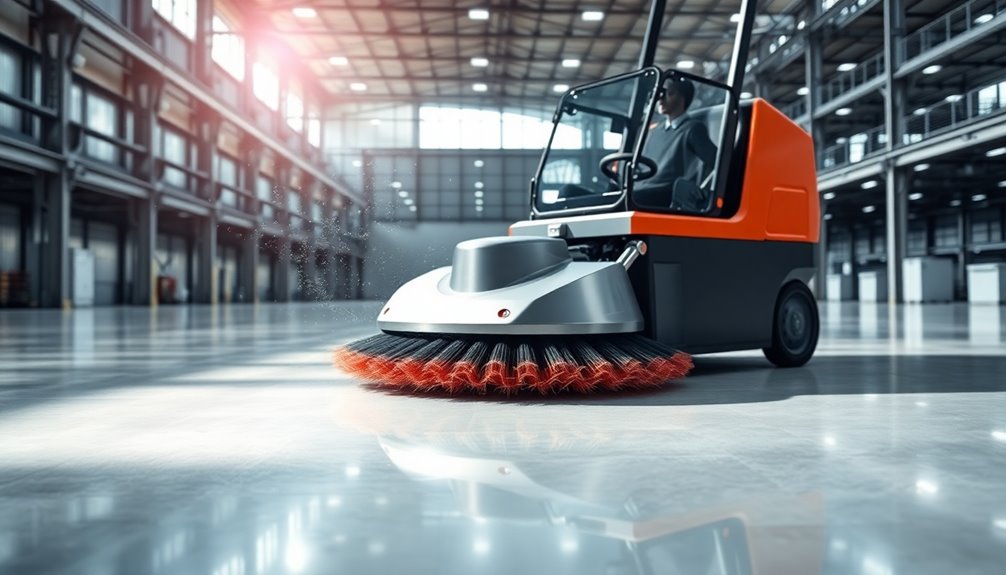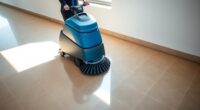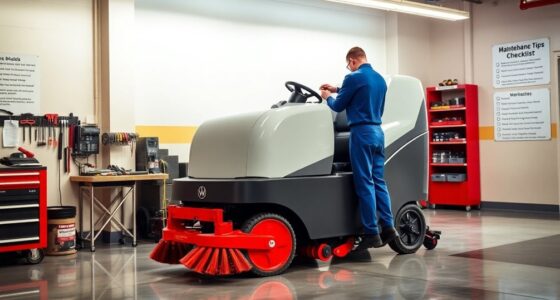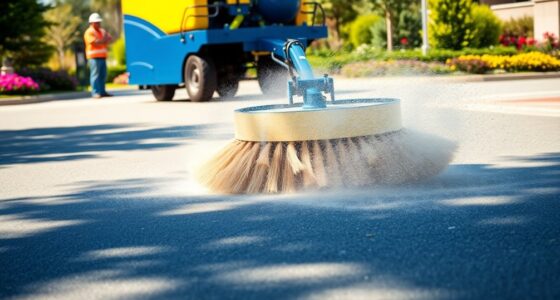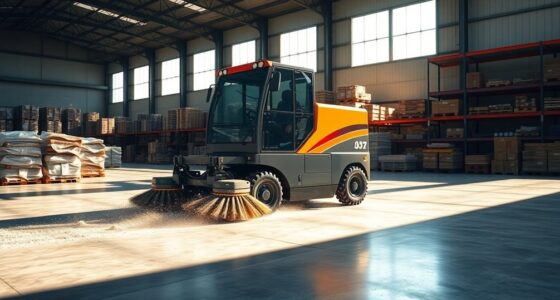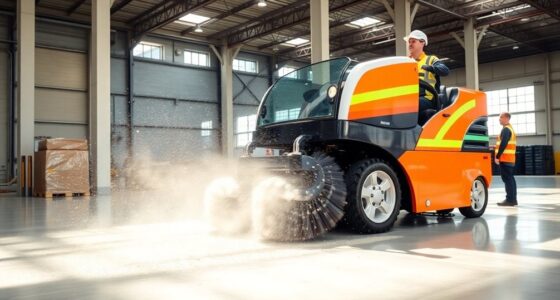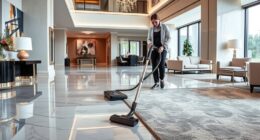Maximize your cleaning strategy with commercial sweeper machines by choosing the right model for your facility's size and debris type. Prepare your sweeper for peak performance by checking battery levels and cleaning brushes regularly. Enhance efficiency by adjusting brush height and training your team on specific features. Regular maintenance guarantees longevity, while troubleshooting common issues keeps operations smooth. These practices not only save time and costs but also improve overall cleanliness. Discover more strategies to elevate your cleaning process.
Key Takeaways
- Choose the right type of sweeper based on area size and debris type to ensure efficient cleaning.
- Regularly maintain your sweeper to enhance longevity and optimize performance through daily inspections and cleaning.
- Train operators on the specific features of each sweeper to maximize operational efficiency and productivity.
- Adjust cleaning frequency based on area usage and seasonal variations to maintain a consistently clean environment.
- Evaluate the return on investment by considering labor savings, improved air quality, and enhanced customer satisfaction from cleaner facilities.
Choosing the Right Sweeper for Your Facility
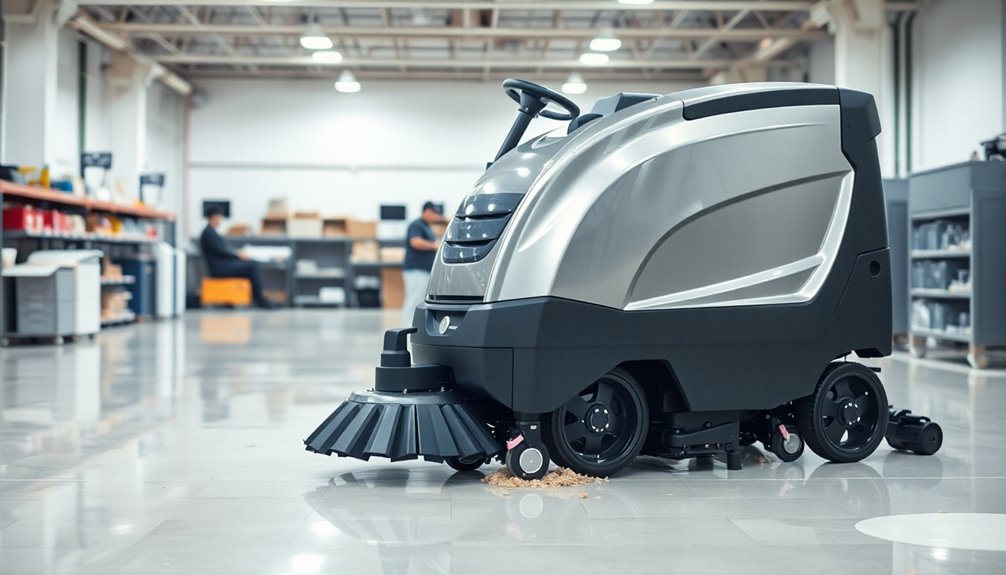
When choosing the right sweeper for your facility, what factors should you consider?
Start by evaluating the size of the area to be cleaned. Larger spaces often benefit from ride-on sweepers that efficiently cover more ground.
Next, think about the type of flooring; a sweeper with adjustable brush height guarantees thorough industrial floor cleaning, especially on uneven surfaces.
Assess the volume and type of debris you need to remove, as machines with greater collection capacity work best in heavy-duty applications.
Decide between manual, walk-behind, or riding sweepers based on your specific needs and operator comfort.
Finally, look for features like vacuum systems for fine dust capture or water tanks for enhanced cleaning, maximizing the effectiveness of your commercial cleaning machines.
Preparing Your Sweeper for Optimal Performance

Before you start cleaning, make sure your sweeper's battery is fully charged and check the brushes for wear.
A quick inspection can save you time and boost efficiency.
Establishing a daily maintenance routine, like emptying the debris tray and cleaning filters, will keep your sweeper in top shape.
Pre-Use Equipment Checks
Getting your commercial sweeper ready for action is essential for peak performance. Before you start, make certain to conduct a few pre-use checks to guarantee your cleaning equipment is in top shape.
- Confirm the battery is fully charged for superior operation.
- Inspect the brush or pad to verify it's suitable for your flooring.
- Clean the filter and check the recovery tank to maximize suction.
Also, don't forget to check the squeegee blade for wear; flipping it can extend its lifespan.
Finally, fill the solution tank with clean water, keeping it below 60°, and add approved cleaning agents for effective results.
These steps will help you get the most out of your sweeper and deliver outstanding cleaning performance.
Daily Maintenance Routine
To guarantee your commercial sweeper operates at its best, start each day with a thorough maintenance routine.
First, check the battery charge level to confirm it's fully charged and ready for cleaning.
Next, inspect the brushes and squeegees for any wear; replace or adjust them as needed.
Don't forget to clean the filters weekly and shake them every 10 minutes during operation to prevent clogging.
Always verify that the debris tray is empty before use, as a full tray can hinder efficiency.
Finally, lubricate moving parts and inspect the suction system daily to keep everything running smoothly.
Maximizing Efficiency During Operation
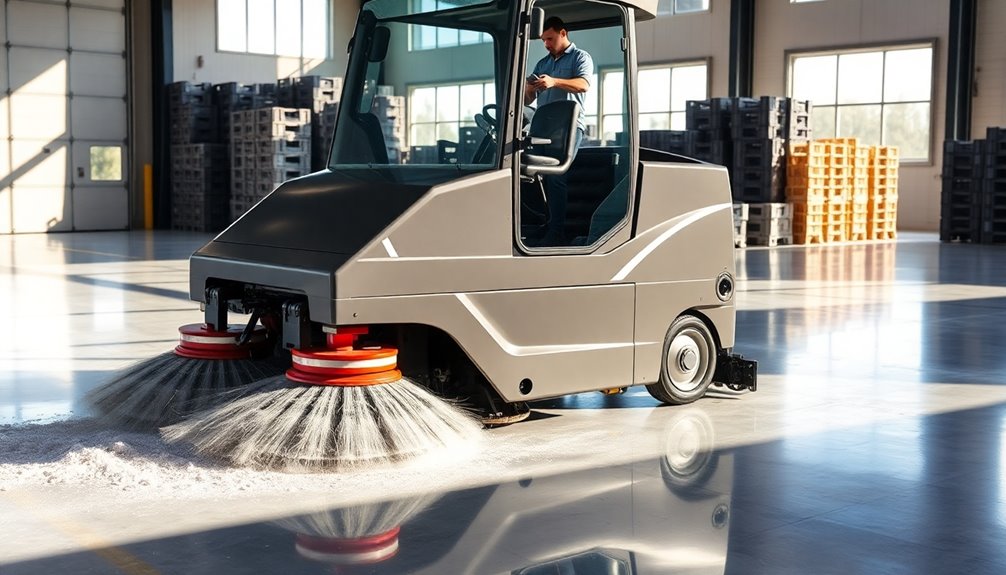
Maximizing efficiency during operation is essential for getting the most out of your commercial sweeper machines.
To enhance operational productivity, consider these strategies:
- Use sweepers that can clean up to 23,000 square feet per hour.
- Adjust brush height and pressure to suit different floor types, ensuring you clean the brush properly to avoid damage.
- Train operators on the specific features of each sweeper or scrubber for effective machine use.
Regular Maintenance Practices for Longevity

To keep your commercial sweeper running smoothly, you should start with a daily inspection checklist.
This includes checking brushes, suction systems, and battery levels.
Regular lubrication also plays an essential role in preventing wear and ensuring peak performance.
Daily Inspection Checklist
A daily inspection checklist is crucial for keeping your commercial sweeper machines in prime condition. By performing daily inspections, you can prevent debris buildup and guarantee peak performance.
Here are a few key tasks to include in your checklist:
- Check the brushes and suction systems for wear or damage.
- Assess the battery levels to avoid unexpected downtime.
- Inspect the debris collection system to prevent blockages.
Regular checks like these not only enhance your industrial cleaning efficiency but also help you identify issues early on. Additionally, consider integrating best home security systems into your facility to safeguard your cleaning equipment when not in use.
Make it a habit to clean filters weekly and follow the manufacturer's maintenance schedule. This approach will prolong your equipment's lifespan and keep your operations running smoothly.
Scheduled Lubrication Routine
After guaranteeing your commercial sweeper machines are in top shape with daily inspections, it's time to focus on a scheduled lubrication routine.
Regularly lubricating moving parts every 30 days, or as recommended by the manufacturer, is essential for smooth operation and preventing wear and tear. This routine should include checking and applying lubricant to critical components like wheels, axles, and gearboxes to maintain peak performance and extend the lifespan of your machines.
Always use the appropriate lubricant specified in the manual to avoid damaging parts. By scheduling lubrication checks alongside daily inspections, you'll not only enhance efficiency but also save time in the long run.
Keeping a log of these activities guarantees proactive equipment care and timely attention to all components.
Troubleshooting Common Sweeper Issues

When your commercial sweeper machine starts showing signs of trouble, addressing the issues promptly can save you time and guarantee cleaning efficiency.
Here are some common problems and solutions:
- Clogged vacuum hoses: These can hinder water absorption, so make sure to clean them before each use.
- Brush bind-up: Debris accumulation can cause this, so clean the brushes after each use and replace them if they're worn down.
- Smelly solution tanks: Dirt buildup can lead to odors; regularly clean the tanks with soap or vinegar.
Understanding Accessory Options for Enhanced Cleaning

Enhancing your cleaning capabilities with the right accessories can make a considerable difference in your commercial sweeper's performance.
Specialized sweeping brushes tailored for different floor types optimize cleaning performance while minimizing surface wear. Adding a water tank for wet sweeping captures dust and dirt more effectively, especially in high-traffic areas.
Consider incorporating vacuum systems to capture fine dust particles, improving air quality and reducing allergens in your environment. Adjustable brush height and pressure settings let you customize your approach for uneven or varied flooring surfaces.
Training Your Cleaning Team for Success

To achieve ideal performance from your commercial sweepers, it's crucial to train your cleaning team effectively.
Make sure your team knows how to use each model's unique features to maximize efficiency. Incorporate hands-on training sessions to enhance their cleaning performance and adaptability.
- Provide troubleshooting knowledge to address issues quickly
- Emphasize adhering to the manufacturer's maintenance schedule
- Foster a culture of safety with best practices for operating equipment
Scheduling Cleaning Routines Based on Foot Traffic

Understanding your facility's foot traffic patterns is essential for scheduling effective cleaning routines.
In high-foot-traffic areas, you should aim to clean daily or even hourly. This prevents dirt buildup and potential hazards.
For medium traffic zones, plan to clean 2-3 times per week to keep surfaces presentable without overwhelming your staff.
Low-traffic areas can typically be cleaned weekly, allowing for minimal disruption while maintaining tidiness for occasional visitors.
Don't forget to take into account the size of each area; larger spaces may demand more frequent cleanings.
Finally, adjust your cleaning routines based on seasonal variations, like increased visitors during holidays, to guarantee your facility remains clean and inviting.
Using a sweeper will enhance your efficiency and effectiveness throughout these routines.
Evaluating the Return on Investment for Sweeping Machines

When evaluating the return on investment for sweeping machines, it's crucial to take into account both the immediate and long-term benefits they offer.
Shifting to a floor sweeper can save you up to 30% in labor costs while efficiently covering 23,000 square feet per hour. This means you won't just save time but also reduce the need to replace equipment frequently due to costly repairs.
Consider these factors:
- Enhanced cleaning efficiency leading to a cleaner environment
- Flexible cash flow options with rental or purchase choices
- Increased customer satisfaction and potential revenue growth
- Improved indoor air quality by effectively removing allergens and pollutants
Investing in commercial sweepers not only streamlines your cleaning process but also protects your bottom line over time.
Frequently Asked Questions
How Can You Maximize Your Cleaning Time?
To maximize your cleaning time, start by creating a tailored cleaning schedule that suits your space and foot traffic.
Focus on high-traffic areas by cleaning them more frequently. Use efficient tools like specialized brushes and vacuums to speed up debris collection.
Train your team on the equipment's features to tackle issues quickly.
Finally, break larger spaces into manageable sections, allowing you to maintain speed and effectiveness throughout the cleaning process.
What Does a Sweeper Use to Clean the Floor?
Did you know that commercial sweepers can reduce cleaning time by up to 50%? A sweeper uses rotating brushes to agitate and lift dirt and debris from the floor.
Many models also feature vacuum systems to capture fine dust particles, improving air quality while you clean. You can adjust the brush height and pressure to fit different flooring types, and some even have water tanks for wet sweeping, tackling stubborn dirt effectively.
How to Clean a Scrubbing Machine?
To clean a scrubbing machine, start by emptying the recovery tank and rinsing it out.
Drain and rinse the solution tank, then clean the filter to remove any buildup.
After use, inspect the brushes and pads, replacing them if they're worn.
Regularly wipe down the machine with an all-purpose cleaner to maintain its appearance.
Don't forget to check for leaks and verify all parts are functioning properly before your next use.
Why Is My Tennant Floor Scrubber Not Picking up Water?
Picture water pooling on the floor, while your Tennant floor scrubber fails to pick it up.
First, check the squeegee blade; worn edges can't make the seal needed for suction.
Next, empty the recovery tank and clean the screen—clogs can kill performance.
Look for hose blockages, and verify the brushes contact the floor.
Finally, a dirty filter restricts flow.
Tackle these issues, and you'll see your scrubber performing like new!
Conclusion
In the grand arena of cleanliness, your commercial sweeper machine is your ultimate champion! By choosing the right model and mastering its quirks, you'll transform your facility into a spotless wonderland. With regular maintenance and a well-trained team, you'll sweep away dirt faster than a tornado on a mission! So, gear up, schedule smartly, and watch your investment pay off like a lottery win. Your space deserves nothing less than the sparkling brilliance only a high-quality sweeper can provide!
